Release 2 (9.2)
Part Number A96587-01
Home |
Book List |
Contents |
Index |
 Master Index |
 Feedback |
| Oracle9i Application Developer's Guide - Advanced Queuing Release 2 (9.2) Part Number A96587-01 |
|
In this chapter we describe the operational interface (publish-subscribe) to Oracle Advanced Queuing in terms of use cases. That is, we discuss each operation (such as "Publish a Message") as a use case by that name. The table listing all the use cases is provided at the head of the chapter (see "Use Case Model: Operational Interface -- Basic Operations" on page 14-2).
A summary figure, "Use Case Diagram: Operational Interface -- Basic Operations", locates all the use cases in single drawing. If you are using the HTML version of this document, you can use this figure to navigate to the use case that interests you by clicking on the relevant use case title.
The individual use cases are themselves laid out as follows:
Each use case is laid out as follows:

See Also:
|
Create a topic connection with username/password
Not applicable.
Java (JDBC): Oracle9i Supplied Java Packages Reference oracle.jms, AQjmsTopicConnectionFactory.createTopicConnection
TopicConnectionFactory tc_fact = AQjmsFactory.getTopicConnectionFactory("sun123", "oratest", 5521, "thin"); /* Create a topic connection using a username/password */ TopicConnection tc_conn = tc_fact.createTopicConnection("jmsuser", "jmsuser");
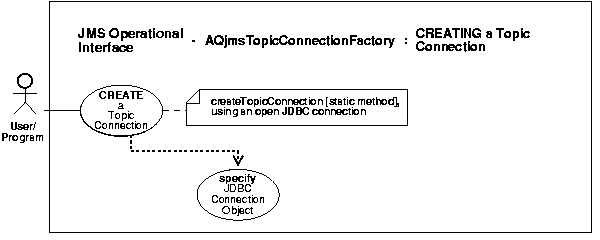
See Also:
|
Create a topic connection with open JDBC connection.
Not applicable.
Java (JDBC): Oracle9i Supplied Java Packages Reference oracle.jms, AQjmsTopicConnectionFactory.createTopicConnection
Connection db_conn; /*previously opened JDBC connection */ TopicConnection tc_conn = AQjmsTopicConnectionFactory.createTopicConnection(db_ conn);
OracleDriver ora = new OracleDriver(); TopicConnection tc_conn = AQjmsTopicConnectionFactory.createTopicConnection(ora.defaultConnection());

See Also:
|
Create a topic connection with default connection factory parameters.
Not applicable.
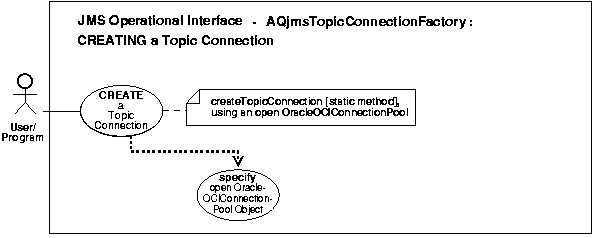
See Also:
|
Create a topic connection with an open OracleOCIConnectionPool.
This is a static method.
Java (JDBC): Oracle9i Supplied Java Packages Reference oracle.jms, AQjmsTopicConnectionFactory.createTopicConnection
This method may be used if the user wants to use an existing OracleOCIConnectionPool instance for JMS operations. In this case JMS will not open an new OracleOCIConnectionPool instance, but instead use the supplied OracleOCIConnectionPool instance to create the JMS TopicConnection object.
OracleOCIConnectionPool cpool; /* previously created OracleOCIConnectionPool */ TopicConnection tc_conn = AQjmsTopicConnectionFactory.createTopicConnection(cpool);
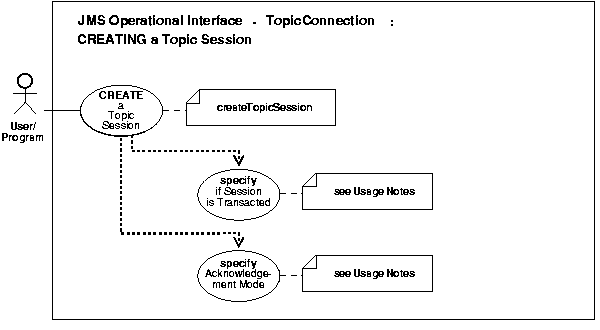
See Also:
|
Create a topic session.
Not applicable.
Java (JDBC): Oracle9i Supplied Java Packages Reference oracle.jms, AQjmsConnection.createTopicSession
TopicConnection tc_conn; TopicSession t_sess = tc_conn.createTopicSession(true,0);
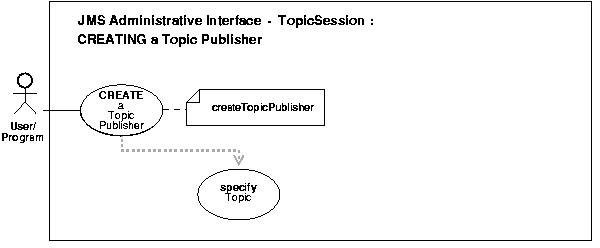
See Also:
|
Create a topic publisher.
Not applicable.
Java (JDBC): Oracle9i Supplied Java Packages Reference oracle.jms, AQjmsSession.createPublisher
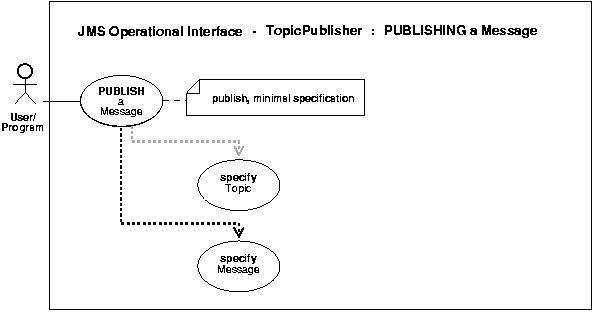
See Also:
|
Publish a message with minimal specification.
If the Topic Publisher has been created with a default topic, then the topic parameter may not be specified in the publish call. If a topic is specified in the send operation, then that value will override the default in the TopicPublisher. If the TopicPublisher has been created without a default topic, then the topic must be specified with the publish. The TopicPublisher uses the default values for message priority (1) and timeToLive (infinite).
Java (JDBC): Oracle9i Supplied Java Packages Reference oracle.jms, AQjmsTopicPublisher.publish
Example 1 - publish specifying topic TopicConnectionFactory tc_fact = null; TopicConnection t_conn = null; TopicSession jms_sess; TopicPublisher publisher1; Topic shipped_orders; int myport = 5521; /* create connection and session */ tc_fact = AQjmsFactory.getTopicConnectionFactory('MYHOSTNAME', 'MYSID', myport, 'oci8'); t_conn = tc_fact.createTopicConnection("jmstopic", "jmstopic"); jms_sess = t_conn.createTopicSession(true, Session.CLIENT_ACKNOWLEDGE); /* create topic publisher */ publisher1 = jms_sess.createPublisher(null); /* get topic object */ shipped_orders = ((AQjmsSession )jms_sess).getTopic('WS', 'Shipped_Orders_ Topic'); /* create text message */ TextMessage jms_sess.createTextMessage(); /* publish specifying the topic */ publisher1.publish(shipped_orders, text_message); Example 2 - publish without specifying topic TopicConnectionFactory tc_fact = null; TopicConnection t_conn = null; TopicSession jms_sess; TopicPublisher publisher1; Topic shipped_orders; int myport = 5521; /* create connection and session */ tc_fact = AQjmsFactory.getTopicConnectionFactory("MYHOSTNAME", "MYSID", myport, "oci8"); t_conn = tc_fact.createTopicConnection("jmstopic", "jmstopic"); /* create topic session */ jms_sess = t_conn.createTopicSession(true, Session.CLIENT_ACKNOWLEDGE); /* get shipped orders topic */ shipped_orders = ((AQjmsSession )jms_sess).getTopic("OE", "Shipped_Orders_ Topic"); publisher1 = jms_sess.createPublisher(shipped_orders); /* create text message */ TextMessage jms_sess.createTextMessage(); /* publish without specifying the topic */ publisher1.publish(text_message);
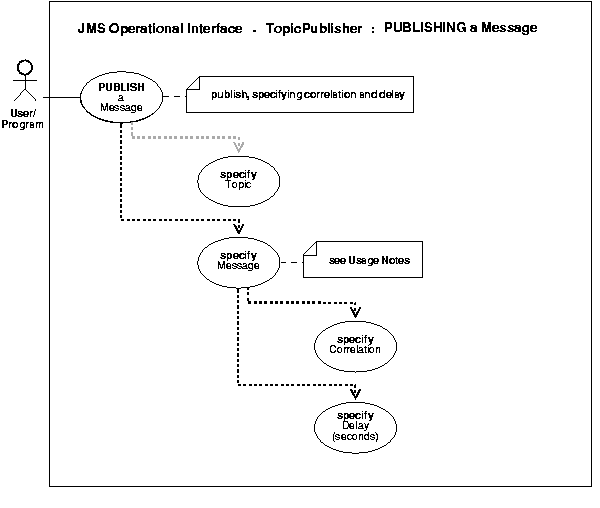
See Also:
|
Publish a message specifying correlation and delay.
The publisher can set the message properties like delay and correlation before publishing.
Java (JDBC): Oracle9i Supplied Java Packages Reference oracle.jms, AQjmsTopicPublisher.publish()
Example 1 - publish specifying delay, correlation TopicConnectionFactory tc_fact = null; TopicConnection t_conn = null; TopicSession jms_sess; TopicPublisher publisher1; Topic shipped_orders; int myport = 5521; /* create connection and session */ tc_fact = AQjmsFactory.getTopicConnectionFactory("MYHOSTNAME", "MYSID", myport, "oci8"); t_conn = tc_fact.createTopicConnection("jmstopic", "jmstopic"); jms_sess = t_conn.createTopicSession(true, Session.CLIENT_ACKNOWLEDGE); shipped_orders = ((AQjmsSession )jms_sess).getTopic("OE", "Shipped_Orders_ Topic"); publisher1 = jms_sess.createPublisher(shipped_orders); /* create text message */ TextMessage jms_sess.createTextMessage(); /* Set correlation and delay */ /* set correlation */ jms_sess.setJMSCorrelationID("FOO"); /* set delay of 30 seconds */ jms_sess.setLongProperty("JMS_OracleDelay", 30); /* publish */ publisher1.publish(text_message);
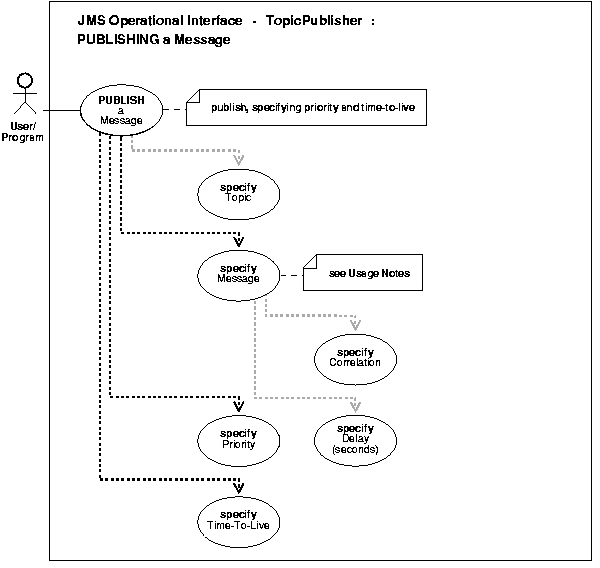
See Also:
|
Publish a message specifying priority and time-to-live.
The priority, and timeToLive of the message can be specified with the publish call. The only delivery mode supported for this release is PERSISTENT.
Java (JDBC): Oracle9i Supplied Java Packages Reference oracle.jms, AQjmsTopicPublisher.publish
Example 1 - publish specifying priority, timeToLive TopicConnectionFactory tc_fact = null; TopicConnection t_conn = null; TopicSession jms_sess; TopicPublisher publisher1; Topic shipped_orders; int myport = 5521; /* create connection and session */ tc_fact = AQjmsFactory.getTopicConnectionFactory("MYHOSTNAME", "MYSID", myport, "oci8"); t_conn = tc_fact.createTopicConnection("jmstopic", "jmstopic"); jms_sess = t_conn.createTopicSession(true, Session.CLIENT_ACKNOWLEDGE); shipped_orders = ((AQjmsSession )jms_sess).getTopic("OE", "Shipped_Orders_ Topic"); publisher1 = jms_sess.createPublisher(shipped_orders); /* create text message */ TextMessage jms_sess.createTextMessage(); /* publish message with priority 1 and time to live 200 seconds */ publisher1.publish(text_message, DeliveryMode.PERSISTENT, 1, 200000);
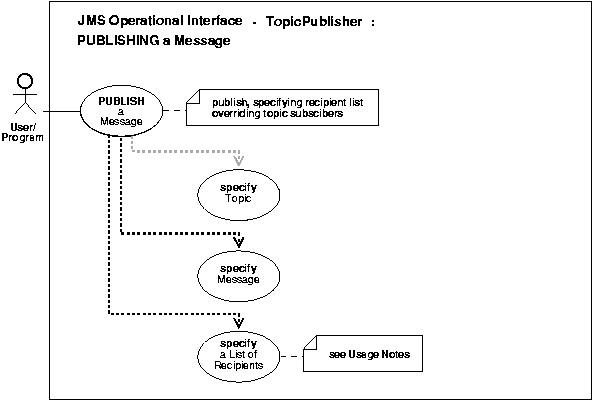
See Also:
|
Publish a messages specifying a recipient list overriding topic subscribers.
The subscription list of the topic can be overridden by specifying the recipient list with the publish call.
Java (JDBC): Oracle9i Supplied Java Packages Reference oracle.jms, AQjmsTopicPublisher.publish
Example 1 - publish specifying priority, timeToLive TopicConnectionFactory tc_fact = null; TopicConnection t_conn = null; TopicSession jms_sess; TopicPublisher publisher1; Topic shipped_orders; int myport = 5521; AQjmsAgent[] recipList; /* create connection and session */ tc_fact = AQjmsFactory.getTopicConnectionFactory("MYHOSTNAME", "MYSID", myport, "oci8"); t_conn = tc_fact.createTopicConnection("jmstopic", "jmstopic"); jms_sess = t_conn.createTopicSession(true, Session.CLIENT_ACKNOWLEDGE); shipped_orders = ((AQjmsSession )jms_sess).getTopic("OE", "Shipped_Orders_ Topic"); publisher1 = jms_sess.createPublisher(shipped_orders); /* create text message */ TextMessage jms_sess.createTextMessage(); /* create two receivers */ recipList = new AQjmsAgent[2]; recipList[0] = new AQjmsAgent("ES", "ES.shipped_orders_topic", AQAgent.DEFAULT_AGENT_PROTOCOL); recipList[1] = new AQjmsAgent("WS", "WS.shipped_orders_topic", AQAgent.DEFAULT_AGENT_PROTOCOL); /* publish message specifying a recipient list */ publisher1.publish(text_message, recipList);

See Also:
|
Create a durable subscriber for a JMS topic without selector.
The subscriber name and JMS topic need to be specified to create a durable subscriber. An unsubscribe call is needed to end the subscription to the topic.
Java (JDBC): Oracle9i Supplied Java Packages Reference oracle.jms, AQjmsSession.CreateDurableSubscriber
TopicConnectionFactory tc_fact = null; TopicConnection t_conn = null; TopicSession jms_sess; TopicSubscriber subscriber1; Topic shipped_orders; int myport = 5521; AQjmsAgent[] recipList; /* create connection and session */ tc_fact = AQjmsFactory.getTopicConnectionFactory("MYHOSTNAME", "MYSID", myport, "oci8"); t_conn = tc_fact.createTopicConnection("jmstopic", "jmstopic"); jms_sess = t_conn.createTopicSession(true, Session.CLIENT_ACKNOWLEDGE); shipped_orders = ((AQjmsSession )jms_sess).getTopic("OE", "Shipped_Orders_ Topic"); /* create a durable subscriber on the shipped_orders topic*/ subscriber1 = jms_sess.createDurableSubscriber(shipped_orders, 'WesternShipping');
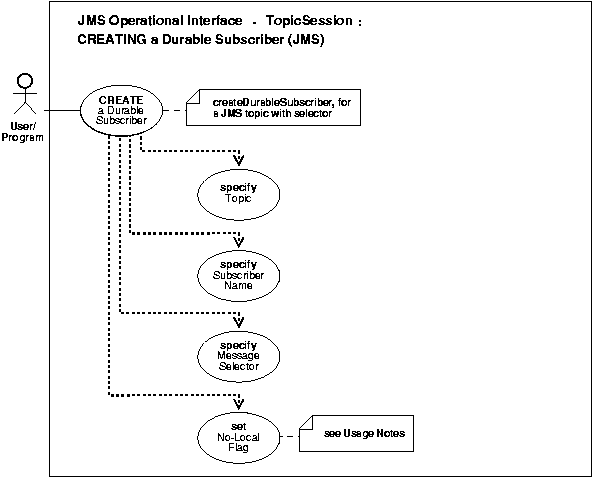
See Also:
|
Create a durable subscriber for a jms topic with selector.
The client creates a durable subscriber by specifying a subscriber name and JMS topic. Optionally, a message selector can be specified. Only messages with properties matching the message selector expression are delivered to the subscriber. The selector value may be null. The selector can contain any SQL92 expression that has a combination of one or more of the following:
For example:
JMSPriority < 3 AND JMSCorrelationID = 'Fiction'
For example:
color IN ('RED', BLUE', 'GREEN') AND price < 30000
Operators allowed are:
A client can change an existing durable subscription by creating a durable TopicSubscriber with the same name and a different message selector. An unsubscribe call is needed to end the subscription to the topic.
Java (JDBC): Oracle9i Supplied Java Packages Reference oracle.jms, AQjmsTopicPublisher.publish
Example 1 - subscribe specifying selector TopicConnectionFactory tc_fact = null; TopicConnection t_conn = null; TopicSession jms_sess; TopicSubscriber subscriber1; Topic shipped_orders; int myport = 5521; AQjmsAgent[] recipList; /* create connection and session */ tc_fact = AQjmsFactory.getTopicConnectionFactory("MYHOSTNAME", "MYSID", myport, "oci8"); t_conn = tc_fact.createTopicConnection("jmstopic", "jmstopic"); jms_sess = t_conn.createTopicSession(true, Session.CLIENT_ACKNOWLEDGE); shipped_orders = ((AQjmsSession )jms_sess).getTopic("OE", "Shipped_Orders_ Topic"); /* create a subscriber */ /* with condition on JMSPriority and user property 'Region' */ subscriber1 = jms_sess.createDurableSubscriber(shipped_orders, 'WesternShipping', "JMSPriority > 2 and Region like 'Western%'", false);
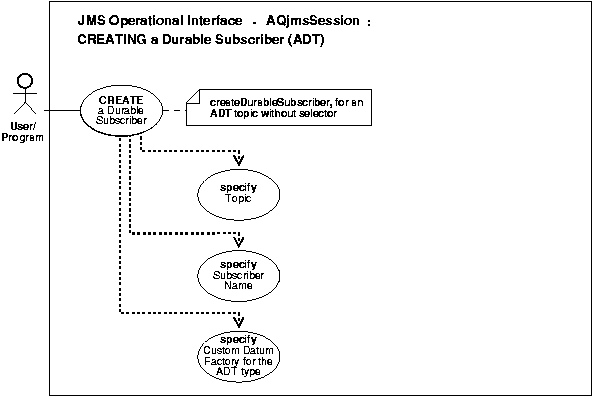
See Also:
|
Create a durable subscriber for an ADT topic without selector.
To create a durable subscriber for a Topic of Oracle Object type, the client needs to specify the CustomDatumFactory for the Oracle Object Type in addition to the Topic and subscriber name.
Java (JDBC): Oracle9i Supplied Java Packages Reference oracle.jms, AQjmsSession.createDurableSubscriber
subscribe to an ADT queue TopicConnectionFactory tc_fact = null; TopicConnection t_conn = null; TopicSession t_sess = null; TopicSession jms_sess; TopicSubscriber subscriber1; Topic shipped_orders; int my[port = 5521; AQjmsAgent[] recipList; /* the java mapping of the oracle object type created by J Publisher */ ADTMessage message; /* create connection and session */ tc_fact = AQjmsFactory.getTopicConnectionFactory("MYHOSTNAME", "MYSID", myport, "oci8"); t_conn = tc_fact.createTopicConnection("jmstopic", "jmstopic"); jms_sess = t_conn.createTopicSession(true, Session.CLIENT_ACKNOWLEDGE); shipped_orders = ((AQjmsSession )jms_sess).getTopic("OE", "Shipped_Orders_ Topic"); /* create a subscriber, specifying the correct CustomDatumFactory */ subscriber1 = jms_sess.createDurableSubscriber(shipped_orders, 'WesternShipping', AQjmsAgent.getFactory());
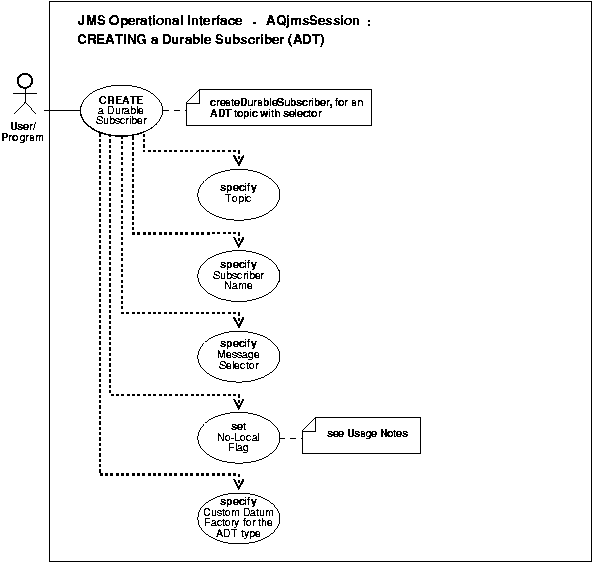
See Also:
|
Create a durable subscriber for an ADT topic with selector.
To create a durable subscriber for a Topic of Oracle Object type, the client needs to specify the CustomDatumFactory for the Oracle Object Type in addition to the Topic and subscriber name.
Optionally, a message selector may be specified. Only messages matching the selector will be delivered to the subscriber.
ADT messages do not contain any user defined properties. However, the selector can be used to select messages based on priority or correlation id or attribute values of the message payload
The syntax for the selector for queues containing ADT messages is different from the syntax for selectors on queues containing standard JMS payloads (text, stream, object, bytes, map)
The selector is similar to the AQ rules syntax
a. Selector on priority or correlation is specified as follows
For example.:- priority > 3 AND corrid = 'Fiction'
b. Selector on message payload is specified as follows. The attribute
name must be prefixed with tab.user_data.
For example:-
tab.user_data.color = 'GREEN' AND tab.user_data.price < 30000
Java (JDBC): Oracle9i Supplied Java Packages Reference oracle.jms, AQjmsSession.createDurableSubscriber
TopicConnectionFactory tc_fact = null; TopicConnection t_conn = null; TopicSession jms_sess; TopicSubscriber subscriber1; Topic shipped_orders; int myport = 5521; AQjmsAgent[] recipList; /* the java mapping of the oracle object type created by J Publisher */ ADTMessage message; /* create connection and session */ tc_fact = AQjmsFactory.getTopicConnectionFactory("MYHOSTNAME", "MYSID", myport, "oci8"); t_conn = tc_fact.createTopicConnection("jmstopic", "jmstopic"); jms_sess = t_conn.createTopicSession(true, Session.CLIENT_ACKNOWLEDGE); shipped_orders = ((AQjmsSession )jms_sess).getTopic("OE", "Shipped_Orders_ Topic"); /* create a subscriber, specifying the correct CustomDatumFactory and selector */ subscriber1 = jms_sess.createDurableSubscriber(shipped_orders, "WesternShipping", " priority > 1 and tab.user_data.region like 'WESTERN %'", false, ADTMessage.getFactory());
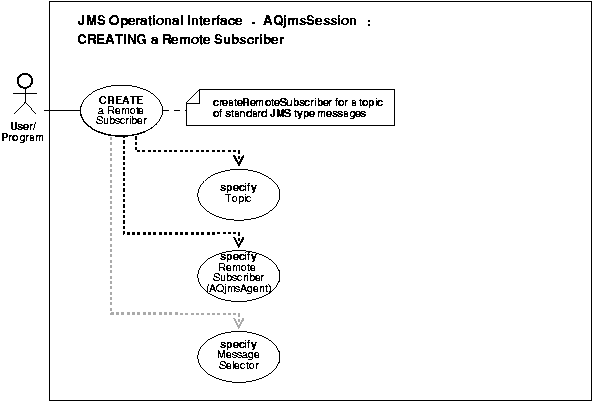
See Also:
|
Create a remote subscriber for topics of jms messages without selector.
AQ allows topics to have remote subscribers, for example, subscribers at other topics in the same or different database. In order to use remote subscribers, you must set up propagation between the local and remote topic.
Remote subscribers may be a specific consumer at the remote topic or all subscribers at the remote topic. A remote subscriber is defined using the AQjmsAgent structure. An AQjmsAgent consists of a name and address. The name refers to the consumer_name at the remote topic. The address refers to the remote topic - the syntax is (schema).(topic_name)[@dblink].
a) To publish messages to a particular consumer at the remote topic, the subscription_name of the recipient at the remote topic must be specified in the name field of AQjmsAgent. The remote topic must be specified in the address field of AQjmsAgent
b) To publish messages to all subscribers of the remote topic, the name field of AQjmsAgent must be set to null. The remote topic must be specified in the address field of AQjmsAgent
A message selector can also be specified. Only messages that satisfy the selector are delivered to the remote subscriber. The message selector can be null. The syntax for the selector is the same as that for createDurableSubscriber. The selector can be null.
Java (JDBC): Oracle9i Supplied Java Packages Reference oracle.jms, AQjmsSession.createRemoteSubscriber
TopicConnectionFactory tc_fact = null; TopicConnection t_conn = null; TopicSession t_sess = null; TopicSession jms_sess; TopicSubscriber subscriber1; Topic shipped_orders; int my[port = 5521; AQjmsAgent remoteAgent; /* create connection and session */ tc_fact = AQjmsFactory.getTopicConnectionFactory("MYHOSTNAME", "MYSID", myport, "oci8"); t_conn = tc_fact.createTopicConnection("jmstopic", "jmstopic"); jms_sess = t_conn.createTopicSession(true, Session.CLIENT_ACKNOWLEDGE); shipped_orders = ((AQjmsSession )jms_sess).getTopic("OE", "Shipped_Orders_ Topic"); remoteAgent = new AQjmsAgent("WesternRegion", "WS.shipped_orders_topic", null); /* create a remote subscriber (selector is null )*/ subscriber1 = ((AQjmsSession)jms_sess).createRemoteSubscriber(shipped_orders, remoteAgent, null);
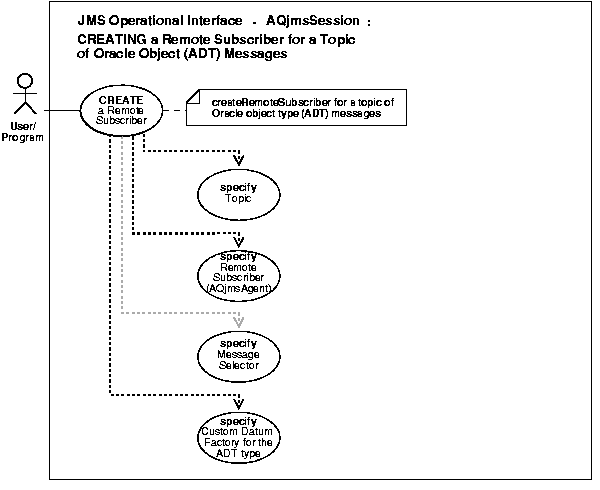
See Also:
|
Create a remote subscriber for topics of oracle object type (ADT) messages.
AQ allows topics to have remote subscribers, for example, subscribers at other topics in the same or different database. In order to use remote subscribers, you must set up propagation between the local and remote topic.
Remote subscribers may be a specific consumer at the remote topic or all subscribers at the remote topic. A remote subscriber is defined using the AQjmsAgent structure.
An AQjmsAgent consists of a name and address. The name refers to the consumer_name at the remote topic. The address refers to the remote topic - the syntax is (schema).(topic_name)[@dblink].
a) To publish messages to a particular consumer at the remote topic, the subscription_name of the recipient at the remote topic must be specified in the name field of AQjmsAgent. The remote topic must be specified in the address field of AQjmsAgent
b) To publish messages to all subscribers of the remote topic, the name field of AQjmsAgent must be set to null. The remote topic must be specified in the address field of AQjmsAgent
The CustomDatumFactory of the Oracle Object type of the Topic must be specified. A message selector can also be specified. Only messages that satisfy the selector are delivered to the remote subscriber. The message selector can be null. The syntax for message selector is that same as that for createDurableSubscriber with Topics of ADT type messages. The message selector may be null.
Java (JDBC): Oracle9i Supplied Java Packages Reference oracle.jms, AQjmsSession.createRemoteSubscriber
TopicConnectionFactory tc_fact = null; TopicConnection t_conn = null; TopicSession t_sess = null; TopicSession jms_sess; TopicSubscriber subscriber1; Topic shipped_orders; int my[port = 5521; AQjmsAgent remoteAgent; ADTMessage message; /* create connection and session */ tc_fact = AQjmsFactory.getTopicConnectionFactory("MYHOSTNAME", "MYSID", myport, "oci8"); t_conn = tc_fact.createTopicConnection("jmstopic", "jmstopic"); /* create Topic session */ jms_sess = t_conn.createTopicSession(true, Session.CLIENT_ACKNOWLEDGE); /* get the Shipped order topic */ shipped_orders = ((AQjmsSession )jms_sess).getTopic("OE", "Shipped_Orders_ Topic"); /* create a remote agent */ remoteAgent = new AQjmsAgent("WesternRegion", "WS.shipped_orders_topic", null); /* create a remote subscriber with null selector*/ subscriber1 = ((AQjmsSession)jms_sess).createRemoteSubscriber(shipped_orders, remoteAgent, null, message.getFactory);
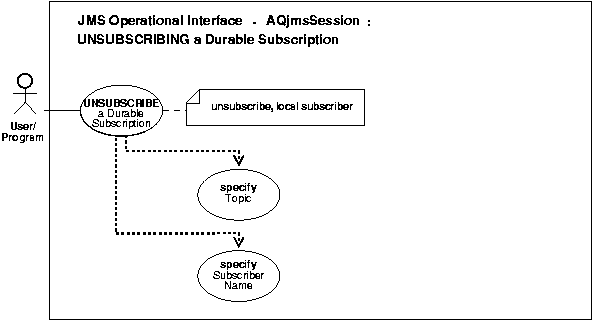
See Also:
|
Unsubscribe a durable subscription for a local subscriber.
Unsubscribe a durable subscription that has been created by a client on the specified topic.
Java (JDBC): Oracle9i Supplied Java Packages Reference oracle.jms, AQjmsSession.unsubscribe
TopicConnectionFactory tc_fact = null; TopicConnection t_conn = null; TopicSession jms_sess; TopicSubscriber subscriber1; Topic shipped_orders; int myport = 5521; AQjmsAgent[] recipList; /* create connection and session */ tc_fact = AQjmsFactory.getTopicConnectionFactory("MYHOSTNAME", "MYSID", myport, "oci8"); t_conn = tc_fact.createTopicConnection("jmstopic", "jmstopic"); jms_sess = t_conn.createTopicSession(true, Session.CLIENT_ACKNOWLEDGE); shipped_orders = ((AQjmsSession )jms_sess).getTopic("OE", "Shipped_Orders_ Topic"); /* unsusbcribe "WesternShipping" from shipped_orders */ jms_sess.unsubscribe(shipped_orders, "WesternShipping");
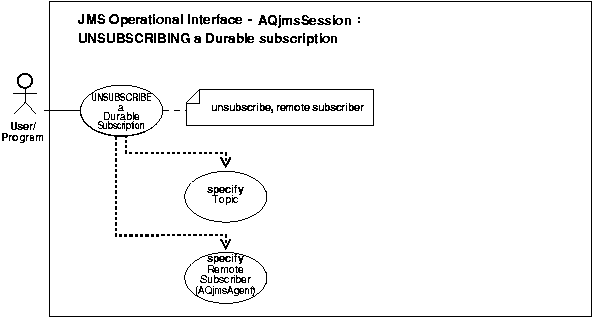
See Also:
|
Unsubscribe a durable subscription for a remote subscriber.
Not applicable.
Java (JDBC): Oracle9i Supplied Java Packages Reference oracle.jms, AQjmsSession.unsubscribe
TopicConnectionFactory tc_fact = null; TopicConnection t_conn = null; TopicSession t_sess = null; TopicSession jms_sess; Topic shipped_orders; int myport = 5521; AQjmsAgent remoteAgent; /* create connection and session */ tc_fact = AQjmsFactory.getTopicConnectionFactory("MYHOSTNAME", "MYSID", myport, "oci8"); t_conn = tc_fact.createTopicConnection("jmstopic", "jmstopic"); jms_sess = t_conn.createTopicSession(true, Session.CLIENT_ACKNOWLEDGE); shipped_orders = ((AQjmsSession )jms_sess).getTopic("OE", "Shipped_Orders_ Topic"); remoteAgent = new AQjmsAgent("WS", "WS.Shipped_Orders_Topic", null); /* unsubscribe the remote agent from shipped_orders */ ((AQjmsSession)jms_sess).unsubscribe(shipped_orders, remoteAgent);
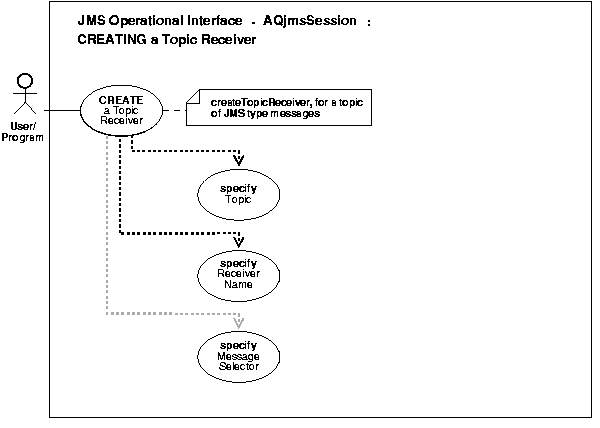
See Also:
|
Create a topic receiver for a topic of standard jms type messages.
AQ allows messages to be sent to specified recipients. These receivers may or may not be subscribers of the topic. If the receiver is not a subscriber to the topic, it will receive only those messages that are explicitly addressed to it.
This method must be used order to create a TopicReceiver object for consumers that are not 'Durable Subscribers'.A message selector can be specified. The syntax for the message selector is the same as that of a QueueReceiver for a queue of standard JMS type messages.
Java (JDBC): Oracle9i Supplied Java Packages Reference oracle.jms, AQjmsSession.createTopicReceiver
TopicConnectionFactory tc_fact = null; TopicConnection t_conn = null; TopicSession t_sess = null; TopicSession jms_sess; Topic shipped_orders; int myport = 5521; TopicReceiver receiver; /* create connection and session */ tc_fact = AQjmsFactory.getTopicConnectionFactory("MYHOSTNAME", "MYSID", myport, "oci8"); t_conn = tc_fact.createTopicConnection("jmstopic", "jmstopic"); jms_sess = t_conn.createTopicSession(true, Session.CLIENT_ACKNOWLEDGE); shipped_orders = ((AQjmsSession )jms_sess).getTopic("WS", "Shipped_Orders_ Topic"); receiver = ((AQjmsSession)jms_sess).createTopicReceiver(shipped_orders, "WesternRegion", null);
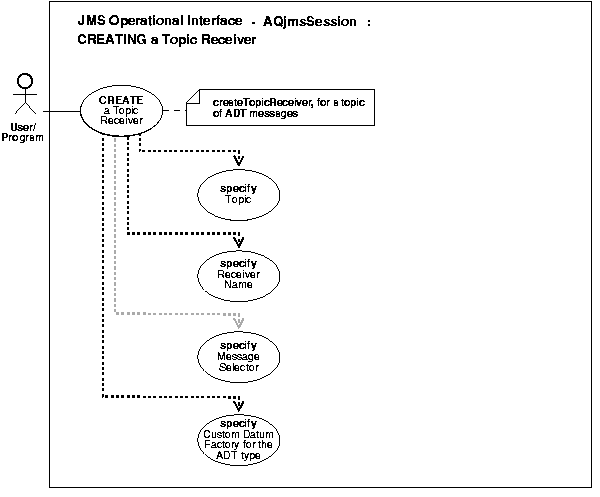
See Also:
|
Create a topic receiver for a topic of ADT messages with selector.
AQ allows messages to be sent to all subscribers of a topic or to specified recipients. These receivers may or may not be subscribers of the topic. If the receiver is not a subscriber to the topic, it will receive only those messages that are explicitly addressed to it.
This method must be used order to create a TopicReceiver object for consumers that are not 'Durable Subscribers'. The CustomDatumFactory of the Oracle Object type of the queue must be specified. A message selector can also be specified. This can be null. The syntax for the message selector is the same as that of a QueueReceiver for queues with ADT messages.
Java (JDBC): Oracle9i Supplied Java Packages Reference oracle.jms, AQjmsSession.createTopicReceiver
TopicConnectionFactory tc_fact = null; TopicConnection t_conn = null; TopicSession t_sess = null; TopicSession jms_sess; Topic shipped_orders; int myport = 5521; TopicReceiver receiver; /* create connection and session */ tc_fact = AQjmsFactory.getTopicConnectionFactory("MYHOSTNAME", "MYSID", myport, "oci8"); t_conn = tc_fact.createTopicConnection("jmstopic", "jmstopic"); jms_sess = t_conn.createTopicSession(true, Session.CLIENT_ACKNOWLEDGE); shipped_orders = ((AQjmsSession )jms_sess).getTopic("WS", "Shipped_Orders_ Topic"); receiver = ((AQjmsSession)jms_sess).createTopicReceiver(shipped_orders, "WesternRegion", null);
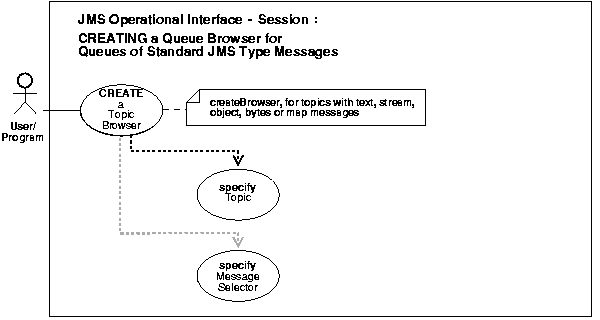
See Also:
|
Create a topic browser for topics with text, stream, objects, bytes, or map messages.
To retrieve messages that have a certain correlationID, the selector for the TopicBrowser can be one of the following:
JMSPriority < 3 AND JMSCorrelationID = 'Fiction'
color IN ('RED', BLUE', 'GREEN') AND price < 30000
All message IDs must be prefixed with "ID:". Use methods in java.util.Enumeration to go through a list of messages.
Java (JDBC): Oracle9i Supplied Java Packages Reference oracle.jms, AQjmsSession.createBrowser
/* Create a browser without a selector */ TopicSession jms_session; TopicBrowser browser; Topic topic; browser = ((AQjmsSession) jms_session).createBrowser(topic, "SUBS1");
/* Create a browser for topics with a specified selector */ TopicSession jms_session; TopicBrowser browser; Topic topic; /* create a Browser to look at messages with correlationID = RUSH */ browser = ((AQjmsSession) jms_session).createBrowser(topic, "SUBS1", "JMSCorrelationID = 'RUSH'");
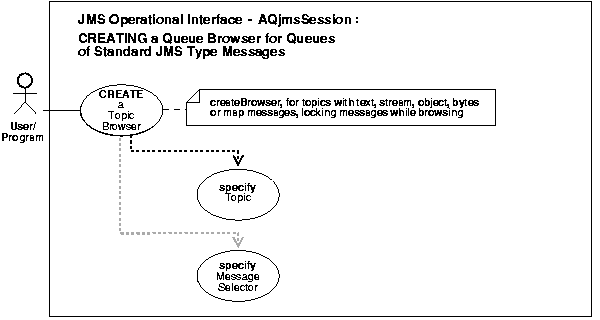
See Also:
|
Create a topic browser for topics with text, stream, objects, bytes or map messages, locking messages while browsing.
If a locked parameter is specified as true, messages are locked as they are browsed. Hence these messages cannot be removed by other consumers until the browsing session ends the transaction.
Java (JDBC): Oracle9i Supplied Java Packages Reference oracle.jms, AQjmsSession.createBrowser
/* Create a browser without a selector */ TopicSession jms_session; TopicBrowser browser; Topic topic; browser = ((AQjmsSession) jms_session).createBrowser(topic, "SUBS1", true);
/* Create a browser for topics with a specified selector */ TopicSession jms_session; TopicBrowser browser; Topic topic; /* create a Browser to look at messages with correlationID = RUSH in lock mode */ browser = ((AQjmsSession) jms_session).createBrowser(topic, "SUBS1", "JMSCorrelationID = 'RUSH'", true);
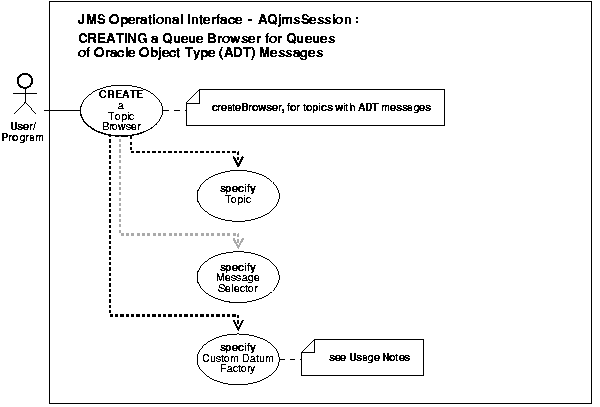
See Also:
|
Create a topic browser for topics of Oracle object type (ADT) messages.
For topics containing AdtMessages, the selector for TopicBrowser can be a SQL expression on the message payload contents or messageID or priority or correlationID.
msgid = '23434556566767676'
Note: in this case message IDs must NOT be prefixed with "ID:"
priority < 3 AND corrid = 'Fiction'
tab.user_data.color = 'GREEN' AND tab.user_data.price < 30000
Java (JDBC): Oracle9i Supplied Java Packages Reference oracle.jms, AQjmsSession.createBrowser
The CustomDatum factory for a particular Java class that maps to the SQL ADT payload can be obtained using the getFactory static method. Assume the Topic - test_topic has payload of type SCOTT.EMPLOYEE and the Java class that is generated by Jpublisher for this ADT is called Employee. The Employee class implements the CustomDatum interface. The CustomDatumFactory for this class can be obtained by using the Employee.getFactory() method.
/* Create a browser for a Topic with Adt messages of type EMPLOYEE*/ TopicSession jms_session TopicBrowser browser; Topic test_topic; browser = ((AQjmsSession) jms_session).createBrowser(test_topic, "SUBS1", Employee.getFactory());
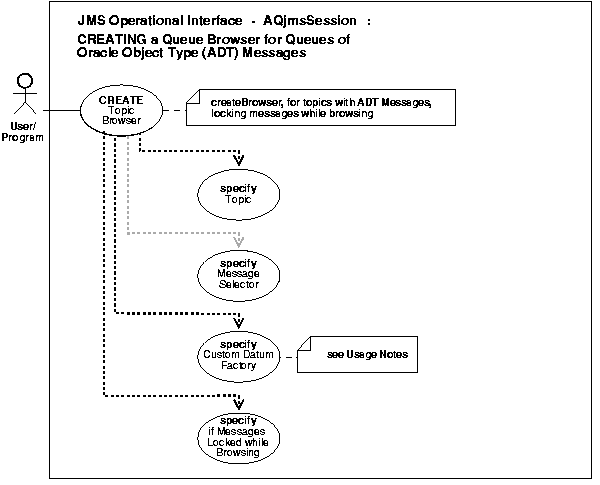
See Also:
|
Create a topic browser for topics of Oracle object type (ADT) messages, locking messages while browsing.
Not applicable.
Java (JDBC): Oracle9i Supplied Java Packages Reference oracle.jms, AQjmsSession.createBrowser
/* Create a browser for a Topic with ADT messages of type EMPLOYEE* in lock mode/ TopicSession jms_session TopicBrowser browser; Topic test_topic; browser = ((AQjmsSession) jms_session).createBrowser(test_topic, "SUBS1", Employee.getFactory(), true);

See Also:
|
Browse messages using a topic browser.
Use methods in java.util.Enumeration to go through the list of messages. Use the method purgeSeen in TopicBrowser to purge messages that have been seen during the current browse.
Java (JDBC): Oracle9i Supplied Java Packages Reference oracle.jms, TopicBrowser, AQjmsTopicBrowser
/* Create a browser for topics with a specified selector */ public void browse_rush_orders(TopicSession jms_session) { TopicBrowser browser; Topic topic; ObjectMessage obj_message BolOrder new_order; Enumeration messages; /* get a handle to the new_orders topic */ topic = ((AQjmsSession) jms_session).getTopic("OE", "OE_bookedorders_ topic"); /* create a Browser to look at RUSH orders */ browser = ((AQjmsSession) jms_session).createBrowser(topic, "SUBS1", "JMSCorrelationID = 'RUSH'"); /* Browse through the messages */ for (messages = browser.elements() ; message.hasMoreElements() ;) { obj_message = (ObjectMessage)message.nextElement(); } /* Purge messages seen during this browse */ browser.purgeSeen(); }
|
 Copyright © 1996, 2002 Oracle Corporation. All Rights Reserved. |
|